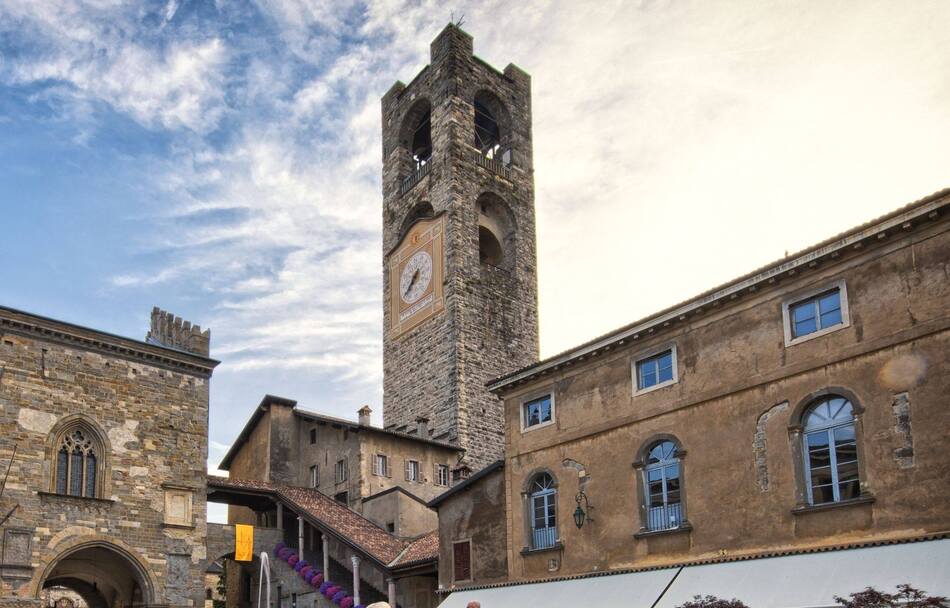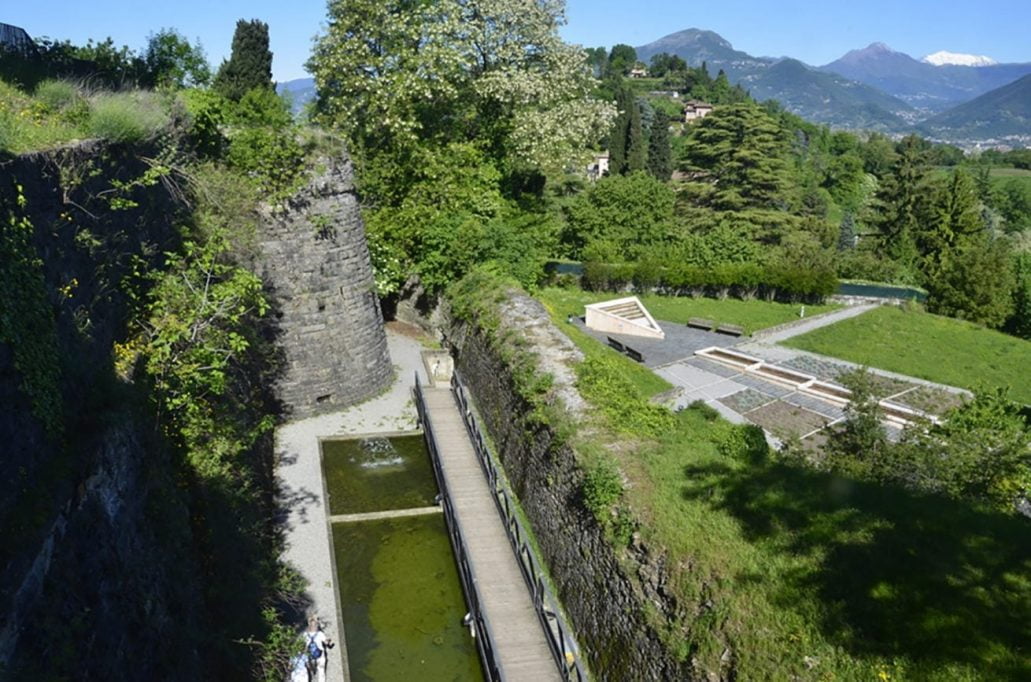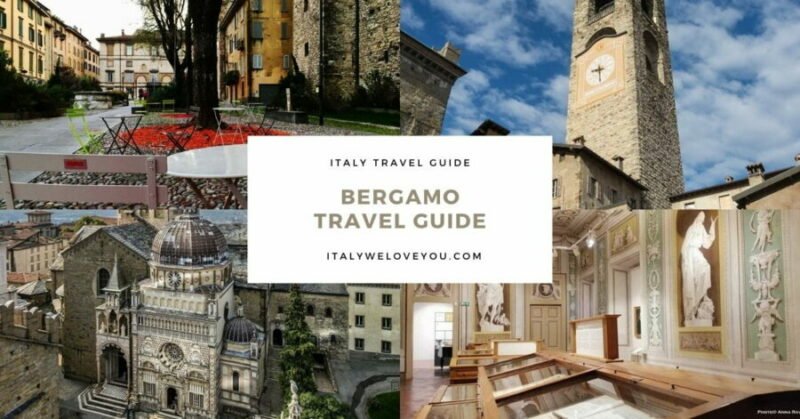15 Best Things to Do in Bergamo, Italy
Bergamo offers many historical and artistic beauties, far from the smog and stress of large cities. It is also well connected with the rest of the world thanks to the nearby Orio al Serio airport, one of Italy’s most important international airports.
The city is divided between Bergamo Alta (Upper Bergamo: the oldest part) and Bergamo Bassa (Lower Bergamo: the most modern).
Top-Rated Tourist Attractions in Bergamo:
Piazza Vecchia (Bergamo Alta)

To reach Bergamo Alta, you need to take the funicular located in Viale Vittorio Emanuele II. You can buy the single ticket (round trip) at the ticket office and enjoy the short, steep slope on this historic funicular, inaugurated in 1887.
Bergamo Alta is the fulcrum of the ancient city, entirely surrounded by walls. The medieval layout is still perfectly recognizable and lays its foundations on pre-existing Roman buildings.
The heart of Bergamo Alta is Piazza Vecchia, one of the most beautiful squares in Europe. The square, like much of Bergamo Alta, is closed to cars. For this reason today this square and its surroundings are a place of beauty and quiet: tranquility is broken only by the stroll of tourists and citizens who come here to meet or sit at the tables of the numerous restaurants and cafes.
Piazza Vecchia is divided from Piazza Duomo by the portico of the Palazzo della Ragione.
At the center of the square is the Contarini Fountain and all around there are the Palazzo della Ragione, the “Campanone” and the Palazzo del Podestà. The fountain was given by the Podestà (governor) of Venice when in 1780 he left his position in Bergamo. It was a way to embellish the square, but above all, to bring water to the center of the Upper Town and make it available to everyone. The fountain has four lions on its sides, the symbol of Venice.
Palazzo della Ragione (Bergamo)

The Palazzo della Ragione is the oldest municipal building in Italy. With the arrival of the Venetians, it was transformed into a court. Destroyed and rebuilt several times, it owes its current shape to the changes made around 1540.
The portico on which it is built serves as a “small square” that divides Piazza Vecchia from the adjacent Piazza del Duomo. Do not miss, on the floor, the sundial of 1798 by Abbot Giovanni Albrici. The sun, passing through a perforated disk placed 7 meters high, illuminates the slabs placed on the floor of the portico indicating the solar noon and the zodiac sign (therefore the month and the season).
You must go to the Palazzo della Ragione at noon to observe this phenomenon. On the first floor of the palace, there is the splendid Sala delle Capriate, a hall with windows and a balcony overlooking Piazza Vecchia.
Here there is the Museum of Frescoes which preserves about 100 frescoes recovered from the city and province of Bergamo. The highlight of the collection are the frescoes by Bramante which adorned the facade of the Palazzo del Podestà.
Palazzo Nuovo

The Palazzo Nuovo, effectively opposed to the Palazzo Vecchio (or Palazzo della Ragione), is recognized by the bright white color of its marbles.
The Palazzo Nuovo houses the Angelo Mai Civic Library, which opened in 1768 thanks to the testamentary bequest of Cardinal Giuseppe Alessandro Furietti.
Keeping more than six hundred thousand volumes, over two thousand incunabula, and more than sixteen thousand manuscripts in its rooms, Palazzo Nuovo in Bergamo Alta is considered one of the most important libraries in Italy.
Campanone

The other great protagonist of Piazza Vecchia is the “Campanone,” which is the Civic Tower. With its 53 meters high, it is one of the highest in Europe and a symbol of Bergamo.
Every evening at 22:00 the tower bells perform their secular function: ringing 100 times to warn of the closure of the four access doors to the Upper Town. And even if the doors no longer close now, the tradition is still alive and not to be missed.
From the top of the tower, the view of Bergamo is beautiful, and to get there, you have two choices: 230 steps on foot or a comfortable lift. Next to the tower is the Palazzo del Podestà. Today it houses a multimedia museum on the history of the city.
Piazza Duomo (Bergamo)

Passing the portico of the Palazzo della Ragione you reach Piazza Duomo, the other important square in Bergamo. If Piazza Vecchia has always been the symbol of administrative power, this is the square of religious power.
The Church of Santa Maria Maggiore is the most important building in the square (and in Bergamo) and owes its construction to a vote against the plague made by the inhabitants in 1133.
Built-in 1137 is characterized by the lack of an entrance door on the central facade. However, it compensated by four splendid lateral access doors. Inside there is a beautiful crucifixion by Ludwig van Schoor and Luca Giordano’s “Red Sea Passage.” At the bottom is the funeral monument of the musician Gaetano Donizetti.
Sant’ Alessandro di Bergamo Cathedral

In reality, the real Cathedral of Bergamo is that of Sant’Alessandro which is attached to the Palazzo della Ragione. The Cathedral is amazing. It houses the Chapel of the Crucifix and paintings by important artists, among which the Martyrdom of San Giovanni Bishop by Giambattista Tiepolo stands out.
On the right of the altar, you will find the chapel dedicated to Pope John XXIII, which preserves the saint’s relics: there is the coffin that housed the body of the “good Pope”, his tiara and other personal items.
Bergamo Alta wash-house (Lavatoio)

Leaving Bergamo Cathedral, take Via Mario Lupo, one of the oldest and most picturesque streets of the Upper Town. Once in Piazza Luigi Angelini, you can admire an ancient washhouse, perfectly preserved.
The Bergamo Alta wash-house (one of the many Upper Town washhouses) remained in use until the 1950s.
The wash house, built by the Municipality at the end of the 19th century, for decades made up for the lack of running water in the houses of Bergamo Alta.
Colleoni Chapel

To the right of the facade of the Basilica of Santa Maria Maggiore is the Colleoni Chapel where Bartolomeo Colleoni, a mercenary soldier who worked mainly in the service of Venice, rests.
Built between 1470 and 1476, it is one of Italy’s most beautiful examples of Renaissance and is dedicated to Saints Bartholomew, Mark, and John the Baptist. An entrance staircase bordered by a wrought iron gate protects the red and white marble columns with symbols and biblical stories around them. Inside, the Sarcophagus of Colleoni stands out with the equestrian statue of the leader in gilded wood.
On the left wall is the funeral monument of Colleoni’s daughter, Medea, who died on March 6, 1470. On the sarcophagus is a Medea statue between Saint Clare and Saint Catherine. The frescoes are by Giambattista Tiepolo. Admission is free.
Donizetti Museum

The city of Bergamo was also the birthplace of the famous composer Gaetano Donizetti, paid by the Lombard community with monuments and museum institutions that celebrate its inspiration and talent every day.
Suppose you want to know the master in more detail. In that case, you must visit the Donizetti Museum: you will be welcomed by the notes of Donizetti’s best-known works, observing documents, photos, and other testimonies on the life and work of the famous Bergamo musician.
Piazza Giacomo Matteotti ( Bergamo Bassa )

You cannot say that you have visited Bergamo Bassa if you are not lost in its alleys: an aimless walk through narrow streets, alleys and shopping streets, to breathe the true atmosphere of Bergamo Bassa.
If the fulcrum of Bergamo Alta is Piazza Vecchia, its counterpart in Bergamo Bassa – the most modern and “social” area of the city – is the square “Piazza Giacomo Matteotti”. There is no shortage of cultural attractions in this area of the city; however, Bergamo Bassa is renowned for its nightlife and shopping.
Therefore, Piazza Matteotti is configured as a meeting point for young people from Bergamo and as a reference point for families and tourists. In particular, the area in charge of shopping in Bergamo is via XX Settembre, a lively area in the Lower City where you can buy everything, thanks to the countless shops all along the street.
Carrara Academy

Although perhaps unknown, the Carrara Academy is one of the most beautiful Italian museums. It is located in Bergamo Bassa, an area rich in history and shops.
The art gallery collects 1793 paintings from the Venetian, Lombard, and Tuscan schools from the Renaissance to the late 1800s.
Among these, works by Gozzoli, Crivelli, Tura, Mantegna, Pinturicchio, Ghirlandaio, Bellini, Raffaello, Tiziano, Lotto, Rubens, Tiepolo, Canaletto, Hayez and many others.
Among the masterpieces are the “Madonna and Child” by Mantegna and that of Titian, the “San Sebastiano” by Raffaello, The “Memory of pain” by Pellizza da Volpedo.
But the whole collection of paintings deserves several hours of visit, together with that of the sculptures with works by Bernini and the prints with works by Mantegna, Dürer, Piranesi, and Canaletto.
In front of the art gallery, there is, instead, the Gallery of Modern and Contemporary Art (GAMeC), ideal for lovers of the most contemporary painters of our time.
Piazza della Cittadella

The current Piazza della Cittadella dates back to 1379. The Visconti family built the Cittadella, designed as a fortified garrison to defend against external attacks and as a safe place in case of popular insurrections.
Today it hosts the Civic Archaeological Museum, the Museum of Natural Sciences “E. Caffi, “and, a short distance away, the Botanical Garden of Bergamo.
Civic museum of natural sciences in Bergamo

The Civic Museum of Natural Sciences “E. Caffi” is designed especially for the little ones: here, it is possible to live interactive and sensorial experiences touching each find, from stuffed animals to the various fossils of different species present at the interior of the museum.
The structure is divided into different “branches” of scientific knowledge, from mineralogy to archeology. It is also advisable to visit the botanical garden, a stone’s throw from the museum, hosting various floristic species.
The Venetian walls of Bergamo

Also, visit the Venetian Walls, a UNESCO World Heritage Site. The 6 km around Bergamo Alta represents an extraordinary defense system built by the Venetians 1561 (on ancient Roman walls) to defend themselves from external attacks.
Fortunately, the walls have never been under siege, so they are perfectly preserved. Along the walls are four entrance gates to the Upper Town and 14 bastions.
Today the Venetian walls can be visited since they have been transformed into a suggestive “walk” for tourists and offer a breathtaking view of the entire Bergamo and the “nearby” Milan.
San Vigilio Castle

Last but not least, the Castle of San Vigilio is also worth a visit, perched on the hill of the same name, which dominates the city from its 496 meters above sea level.
If you want to see it up close and enjoy the panoramic view of the hill, you can reach the Castle of San Vigilio on foot or with the second funicular that departs from Bergamo Alta.
Read Also: Best Restaurants in Bergamo
Think your friends would be interested? Share “Things to do in Bergamo”!







